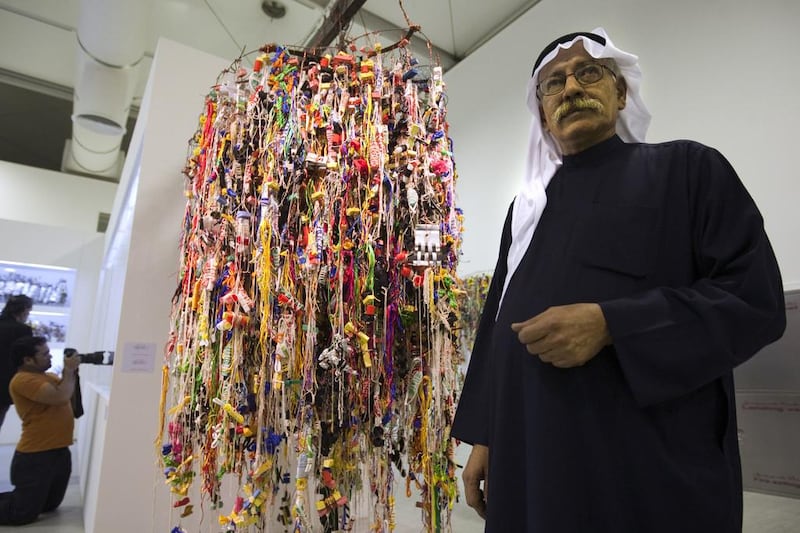Hassan Sharif, arguably the most famous Emirati artist, died last night at the age of 65. He had been suffering from cancer. His funeral was held this morning.
Upon hearing the news, many of the UAE’s leading cultural figures paid tribute to the man who was affectionately known as the father of the country’s contemporary art scene.
The founder of the Sharjah Art Foundation, Sheikha Hoor Al Qasimi, who featured Sharif’s work in her curated exhibition for the UAE Pavilion in Venice last year, was devastated by the news.
“Truly heart-broken today,” she wrote on social media. “May he rest in peace.”
Sultan Sooud Al Qassimi, the founder of Barjeel Art Foundation and a keen collector of Sharif’s work also took to social media to pay his respects. “[He was] a giant of UAE and Middle Eastern art: Rest in peace,” he wrote.
While Emirati photographer Ammar Al Attar, who visited Sharif in 2014 in his Al Barsha studio where he took his portrait for Art Index — an exhibition of key members of the UAE’s art community — posted the portrait on his feeds with a moving caption that read: “True artists never die, their work lives on forever”.
Born in 1951 in Dubai, Sharif pursued ways of commenting on the UAE’s social landscape from as early as 1973 when he began drawing humorous caricature cartoons that were printed in local newspapers. In 1979, he was one of the first Emiratis to pursue an arts education abroad by studying in England.
After a foundation year studying in Leamington Spa, Sharif enrolled at the Byam Shaw School of Art in London, which is now part of Central Saint Martins, and fostered an interest in abstract and experimental art.
Graduating in 1984, Sharif returned to the UAE, and in addition to being one of the founding members of the Emirates Fine Arts Society, he set about staging the first exhibitions of contemporary art the country had seen.
He also founded Al Marijah Art Atelier in Sharjah in 1984, a meeting place for a new generation of young artists. He held informal sessions as teacher and mentor in the atelier and, as not all could read or speak English, he would help them to read the art books he had brought back with him from the UK.
Mohammed Kazem, now one of the UAE’s greatest talents, was his first protégé. From the age of 14, Kazem spent as much time as possible with Sharif in the atelier, going against the grain of his family’s wishes. An internationally renowned painter, Kazem’s art work is currently on display at the inaugural Yinchuan Biennale in China until December 18.
One of Sharif’s defining moments was a groundbreaking one-day exhibition that he and fellow artist Abdul Rahim Salem staged in Sharjah’s central market in 1985.
They tied pieces of string and rope around rocks and placed them in the central thoroughfare of the market.
During an interview held last year in his Al Barhsa studio, he told me that most people ignored the art work. It was only children and eventually the police that enquired about what the duo was doing. It was a seminal moment in art history — Sharif had brought conceptual performance art to the country.
“I didn’t only make art but I made my audience too,” he said. “I had to contextualise what I was doing.”
At this time, Sharif also began what was to become a career long obsession with infusing everyday objects into his art works as “illustrations of meaninglessness”.
He would take newspaper, cardboard sheets, scrap metal, plastic cups, foam flip flops, spoons and other banal items and tie them together with rope or wire, thus stripping them of their original function and making a comment on consumerism with them.
It was in the last decade of his life that his contributions to the UAE’s art scene became apparent. In 2007, with his two brothers Abdul Raheem Sharif and Husain Sharif, he founded Flying House, a studio and exhibition space in Al Quoz.
At the time, it was the only contemporary art space showcasing Emirati art. Sharif’s work also began to gain international attention at this time. In 2009, his works were shown in the UAE’s inaugural pavilion at the Venice Biennale and one of his installations which was made of used slippers and wire, was shown at the Sydney Biennale that same year.
Sharif was the first Emirati to show at Doha’s Mathaf Arab Museum of Modern Art in 2010 and the following year at Abu Dhabi’s Qasr Al Hosn festival, as part of a retrospective of his career curated by Kazem and Catherine David, the deputy director of the National Museum of Modern Art the Georges Pompidou Centre in Paris.
He was represented by Gallery Isabelle Van Den Eynde in Dubai as well as Alexander Gray in New York and had shown his work several times in Whitechapel Gallery in London.
Gallery Isabelle van den Eynde released a statement following the news saying: ‘He (Sharif) didn’t put stock in conventions of age, identity or the need for comfort. Only art and the restless making of art grasped his attention. He was a prolific cultural producer and facilitator, moving between roles as artist, educator, critic, activist, and mentor.’
“We all learnt from him. He was a pioneer in the UAE art scene and will be missed,” said Sheikha Latifa Bint Maktoum, founder and director of Tashkeel studio art hub. “But his memory and teachings will remain for generations to come.”
Hassan Sharif: January 1, 1951 — September 18, 2016





